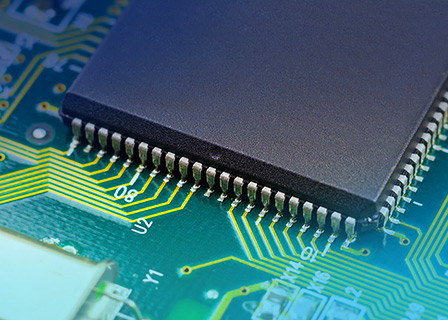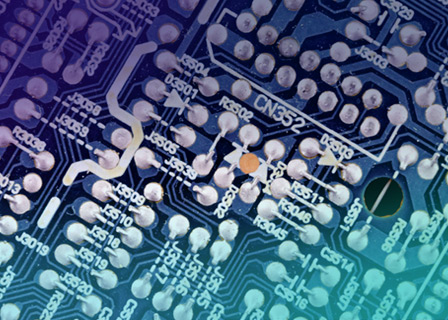
We explore architectures and microarchitectures for processors in edge devices. These processors are ultra-low-power and require nonvolatile memory, high energy efficiency, and ability to maintain time and their state even when they are powered-off.
We design circuits for such nonvolatile processors. Those circuits may function in sub- or near- threshold voltage and contain nonvolatile memories to store their states. These processors also combine accelerators for improved energy efficiency and use different technologies to maintain unique functionality instant-on normally-off operation.

We investigate emerging non-volatile memristive memory technologies, such as Resistive RAM (RRAM), Phase Change Memory (PCM), Spin-Transfer Torque Magnetoresistive RAM (STT-MRAM), Spin-Orbit Torque Magnetoresistive RAM (SOT-MRAM), Conductive Bridge RAM (CBRAM), as replacements for conventional memory technologies.

We are tackling the fundamental memory-wall bottleneck by proposing a redesigned computer architecture that enables true in-memory processing by exploiting physical devices that are inherently capable of both information storage and logic.
At the core of this emerging architecture is the memristive Memory Processing Unit (mMPU) that enables computation within the computer memory itself, thereby diminishing the need for data-transfer across the computer.

Neuromorphic Computing has emerged as an exciting research area, primarily owing to the paradigm shift from conventional computing architectures to data-driven and cognitive computing beyond von Neumann architecture. Encouraged by the ever-growing data-rich world, and inspired by the attractive features of neurobiology, neuromorphic computing holds a promising future. With the imminent need for intelligent, reconfigurable, energy-efficient, fault-tolerant, adaptive and versatile computing. An interdisciplinary technology that combines biology, physics, mathematics, computer science, and electronics to design artificial neural systems.
Our work includes neural network accelerators, trainable data converters, as well as the associated security mechanisms for robust computing. We focus on artificial neural networks (ANN) and spiking neural networks (SNN) and look on both inference and training.

Bio-inspired electronics include neuromorphic electronics, which aims to build brain-like systems like artificial retinas, and cytomorphic electronics, which aims to emulate and understand cells, their processes and utilize them for emulating various genetic networks like the delay-induced oscillators and the interaction between p53 and mdm2 in cancer signaling pathways.
These circuits can have numerous applications, which include building an environment for emulating biological systems and observing the effects of various drugs on these systems and abnormalities within them, building low-power, efficient, and noise-tolerant computing systems using concepts and principles from biology, building bio-inspired devices like event cameras, devices for monitoring and diagnosis of diseases using electronic devices, etc.

Memristors ushered a new age for computing and memory architectures due to their small size, fast switching and memory retention. These same characteristics can also be used to build new analog & RF circuits or improve the performance of existing circuits. Using memristors in analog electronics will allow creating new designs that are smaller, more reliable, more energy efficient, more linear and with lower noise.
Memristor-based RF circuits are able to operate in very high frequencies, while having smaller insertion loss than today’s alternative technologies. Such circuits would allow using smaller gain and power active stages and by thus reducing power, area and cost.

The ubiquitous computing demands have driven the rapid growth of embedded devices, such as wearable devices. On the one hand, these devices are limited in computing resources and power budget. Developing a secure embedded application community relies heavily on implementing the fundamental security primitives: Physically unclonable functions (PUF) and true random number generators (TRNG). On the other hand, the enormous and ever-increasing generated by these devices requires efficient in situ data-aware processing. Memristive technology could meet these two demands at the same time. Memristors are found to be suitable for TRNG and PUF designs because of their inherent and easily extractable random characteristics. Moreover, memristor computing systems could process data directly in memory.
However, these systems may be vulnerable to various advanced attacks, such as side-channel and fault attacks. Those security vulnerabilities may hinder the systems’ development and application.

The demand for high performance low power microprocessors is increasing. Since Moore’s law for transistors is reaching saturation, superconductive technology is a potential technology to achieve energy efficient high-performance computing. Superconductivity is a phenomenon in which conductors exhibit zero DC resistance. Coupling two superconductors with a weak link introduce the active device used in superconductive circuits, the Josephson junction (JJ). Utilizing this phenomenon and the JJ, new logic families have been proposed in which logic values are presented as the presence or absence of a single flux quantum (SFQ) pulse.
At ASIC2, we explore design methodologies and circuits for SFQ logic.

As part of our research, we develop different tools and models, useful for design and simulations.
These models and tools are usually open-source and are publicly available to the scientific community. It includes device models (mostly known as the TEAM model), memory modules, design automation tools, and architecture simulators.